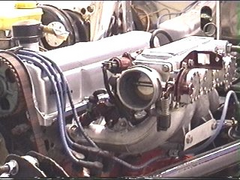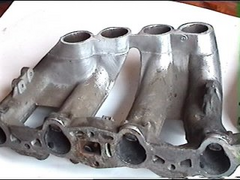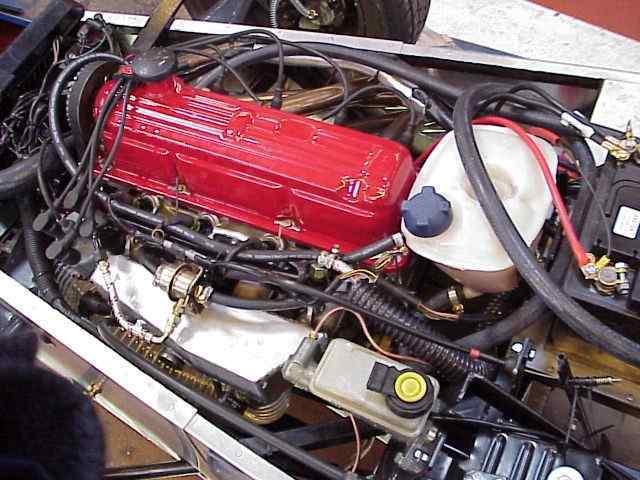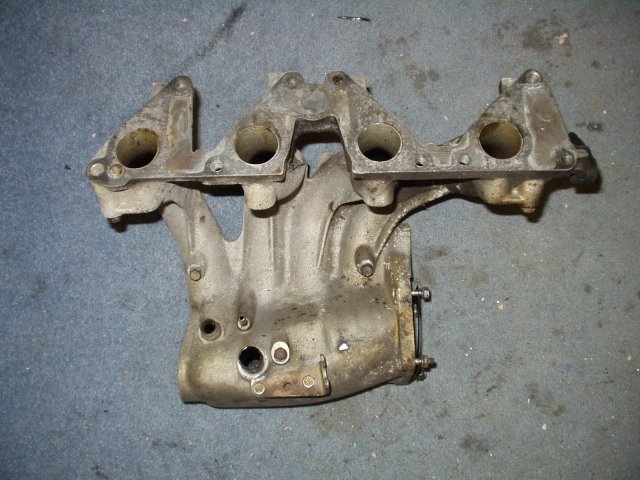In any event, I am going the chop mine down - I just want a head start on any difficulties others have come across when doing this
Mark


Rescued attachment 250401-EFi4.jpg

Has anyone tried the Hoodie developed mod for the EFi plenum chamber? The guy who has done it wants £25 for the instructions and 4 blanking plates, he
says that no welding is required, so I guess that the thing is glued back together?
In any event, I am going the chop mine down - I just want a head start on any difficulties others have come across when doing this
Mark


Rescued attachment 250401-EFi4.jpg
I'd be interested in this as I intend to put the EFi eventually, is that a picture of it lowered Mark?
Cheers
Chris
It's a shot of one done in a 2B, the plenum is cut off about half way and where it enters the throttle chamber, then joined again under the throttle
chamber - the details I have yet to find out!


Rescued attachment efi_1.jpg
hmm no welding ..............? possible I reckon.
You could try and get some info of the belgium tiger importer. they do something simular. They bought my engine some time ago.
Any site address?
Mark,
I've done it on a 2.0 pinto in an Indy. I bought the kit to get an idea but I wasn't confident that it would fit - it didn't - I had to be more
aggresive with the reduction. Photos in Cairb - Under bonnet. Theres a steel plate that fits between the 2 cut sections with screws passing through
into the ally from both sides. No welding ... apart from a bit of filling to give a bit more meat for the screws. It seems to drive well enough.
Did you need to cut it down further for the height or the width? I hadn't considered turning the throttle chamber the other way around, what are the
advantages/disadvantages?
Mark
It was all a bit tight width and height wise. turning it round seemed to give a better chance at mating up the cut down tubes to the underside of the
plenum chamber. Disadvantage at the moment is the ducting of cool air for the inlet, but its currently pulling sub 6s 0-60 so its probably not too
detrimental, or is there more grunt available  .
.
The kit was useful for seeing how it had been done but I think that there's a tad more room under the Hoods hood. I only used a small part of the kit
in the end.
There was a web site where someone fabricated a new plenum and fitted pressed tubes into the cut down section close to the injectors.
I found that once I'd started cutting the unit it became a challenge, it was a bit of a job but hopefully in the locost spirit.
I'm currently looking into fitting a wide band O2 sensor to get a handle on whether there's any gain to be had by modifying the injection, has anyone
any experience?
I'm looking into doing this on my Vx Inlet maqnifold. What are the principles? I'm guessing airflow must not be restricted etc.
I'd like as much info as poss please.
There is a local company who could weld it for me.
Thanks
Northy,
I'm not sure how it would work on yours. Cutting mine back further makes the rear inlet come into the plenum at a slight angle and due to the
thickness of the plenum there was only a limited amount of radiusing that could be done at the inlet entry. Both of these are going to reduce the
flow. Also the inlet length is reduced which will push up the rev range the point at which resonance will occur, loose some bottom - gain some top.
However, I worked on the basis of suck it and see, or was it blow it?
It if doesn't work the main cost is time, oh and then the throttle bodies etc
CairB,
Were the bits you cut out quite straight? The ones on the VX curve a bit.
What do you mean by pushing up the rev range the point at which resonance will occcur? You lost me there!
Loose some bottom - gain some top?
Thanks
Northy,
I think that if you look at the photo Cairb - Under bonnet side view, and Marks picture earlier on in this thread you will get some idea of the shape
of the cut out section. It was tricky as the pipes curve a lot for the rear cylinder, which is the one that connects at a slight angle. The kit is
based on the picture that Mark showed where the pipes were still round in cross section. Mine deviate somwhat from this, but it doesn't seem to affect
performance significantly.
When the inlet manifold length is reduced then the pressure waves that bounce between the changes in cross sectional area of the duct will increase in
frequency, hence the useful effect of getting extra charge in the cylinder will occur higher up the rev range, all else being the same. I believe that
the original length of the inlet manifold was to give boost at the lower RPM range. How significant this effect is on a 'cooking' engine is debatable.
Hence the term lose some bottom - gain some top. I think that there was a reference to a University students thesis on the subject recently - sorry
can't remeber the link.
I hope this clarifies.
Cheers
northy are you avonbuilder on mig??
is the vaux lump a 16 or 8v?
i would say that shortening the runners is a bad idea as they are a tuned length to the plenum.
this can throw the afm out iirc as pulses coming back up the inlet confuses the afm. this is supposed to be worse with a performance cam.dont know how
the form system works but i presume its similar
imo if access is a problem i would have thought a set of webers would be a better idea than hacking the injection around.
Thanks,
Yeah thats me. It is an 8 Valve. Fitting carbs doesn't seem straight forward either 
Don't know what to do now 
I researching this a bit, everyone seems to have done it differently, just found another interesting one, it may be a bit more involved
though


Rescued attachment Radical Mod EFI2.jpg
Have you seen this one?


Rescued attachment Moded Inlet Manifold Cat.jpg
This is what I am trying to modify 


Rescued attachment EFi Manifold Standard.jpg
That is one seriously awkward shape!!
Best of luck
I'll second that - I thought the pinto was tricky. It looks like you would end up with some awkward tube intersection angles depending on how much
needs to be removed. Have you come across anyone else that has modified this type?
Mark,
Your previous picture was the one that I was refering to with the pressed in tubes. It's probably not too bad once the manifold has been bored out as
long as its welded in a particular sequence and gives the opportunity to get the plenum end of the inlet pipes with adecent entry radius. Have you
decided which way to go yet?
Cheers,
Colin
Colin,
I know it's changing the subject slightly, but what was the wiring like, that's the bit that's worrying me! Do you have a wiring diagram?
cheers
Chris
I quite like the idea of making my own plenum chamber, not even I can weld mild steel to aluminium so I am going to check out the heat resistance of
the structural adhesives we use at work.
I was thinking about making the outer part of the modified inlets into trumpets to increase the efficiency, would this work even though they are
inside the plenum chamber?
I have got a copy of the piper tuning manual somewhere, it has all kinds of maths for working out lengths of inlets and exhausts to give maximum power
at prefered RPM's - just cannot find it at the moment!
Chris,
Sent a U2U2U
Mark,
I think that radiusing the inlet entry would help in the plenum as long as they don't protrude into the chamber significantly. What it's trying to do
is to get the air into the tube witout the sideways flow becoming significant and reducing the effective area.
As for the tubes I would have thought that the inlet temperature rise would be less than 80C which should give scope for a slight interference not
coming loose, the adhesive could be used to help seal, if the ally is heated then you would get the tubes in without wiping away all the adhesive.
[Edited on 4/3/03 by CairB]
Can someone post a picture of the Pinto Inlet so I can see the difference? It might help me work out how to do it.
Thanks
whats the problem with webers northy ??
is that 8v with single throttle opening or twin ??
the runners are long which helps with mid/low torque.
put a post on mig about modifying the plenum and see what they say but i think you will find that they will say to keep the runners the same length.
Northy,
I've posted a photo in Cairb - Pinto Plenum before modification for your perusal.
Cheers,
Colin
The dissy has no mechanical advance. So what do I do?
Oh, and Webers will set me back ~£500
Piper Tuning Manual says...
length ram pipes in inches = (228xinlet valve timing in degrees) / RPM of max power less 500RPM
The result can be divided by 3 or 5 to accomodate the ram pipes. the length of the ram pipes is from the valve head to the trumpet end.
The clearance from the end of the trumpet to its opposite face in the air box must not be less than the bore of the choke.
Now, does anyone know the inlet valve timing for a 2.0i Pinto????????????
Calculator in sweaty palm poised for action!!
According to Haynes - Inlet:
opens 24deg BTDC
closes 64deg ABDC
gives a duration of 268 deg.
I think that my Kent FR34 is about 263 duration.
Press them keys 
11.11" assuming max power rpm of 6000, the standard sierra one looks much longer, but divided by 3 would give 3.7" Seems very short to me - what does the panel think?
I suggest that you follow your nose, take your pick and make something to regulate and get the charge into the engine. I did, it works to a reasonable
extent with good drivability, not bad acceleration and nearly 30mpg to boot when given some hammer. If you don't like the result you can always pond
it and try the MKII. During my build I found that I could spend a lot of time pondering and with the aid of my son saying is that all you've done this
week I'd get the drift and get on with it.
By the way, whichever way you choose I bet you get half way through and convince yourself that the other way was better.
I wasn't sure that the injection and ignition mapping would be OK but it seems to be. Thats why I'm looking at fitting an O2 sensor to see if thers
any more to be had my changing the mapping.
Good luck with it - whichever way you go.
Bugger the calculator, going to make my own throttle chamber and make the rams as long as they will go without sticking out of the side of the car!
Mark,
You MUST post pictures! It sounds like a fine plan to me 
Mark,
You MUST post pictures! It sounds like a fine plan to me 
dissy off a 1600 carb is what you want for webers.
http://www.migweb.co.uk/forums/showthread.php?s=&threadid=65621
what about one of these manifolds ?? see thread / link above
Which way up does the lexmaul one go? I need to deduce the height of mine.
The one half way down the page looks interesting.
Thanks
I have a doc from this site (www.sdsefi.com/techinta.htm) which shows a home made EFI system, take a look and do whatever. (yes i do spend to much time online, I admit. suspension design is waiting)
Mark,
Any progress yet?
I've just finished my plenum chamber. I based it on the original Toyota design, but lowered it to fit under the bonnet. It's made from four 90-degree
exhaust manifold bends for the inlet runners, a length of 3" pipe for the main plenum body and a 10mm plasma cut flange (drawn around a stock inlet
manifold gasket and plasma-cut & ground to shape).
Pictures are here and here